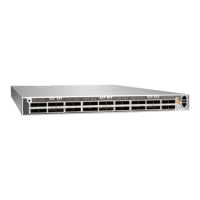LASER WARNING: Do not look directly into a ber-opc transceiver or into the ends of
ber-opc cables. Fiber-opc transceivers and ber-opc cables connected to
transceivers emit laser light that can damage your eyes.
LASER WARNING: Do not stare into the laser beam or view it directly with opcal
instruments even if the interface has been disabled.
1. If the ber-opc cable connector is covered by a rubber safety cap, remove the cap. Save the cap.
2. If the opcal transceiver is covered by a rubber safety cap, remove the cap. Save the cap.
3. Insert the cable connector into the opcal transceiver.
4. Secure the cable so that it does not support its own weight. Place excess cable out of the way in a
neatly coiled loop. Placing fasteners on a loop helps cables maintain their shape.
CAUTION: Do not bend ber-opc cables beyond their minimum bend radius. Bending
the cables beyond their minimum bend radius can damage the cables and cause
problems that are dicult to diagnose.
CAUTION: Do not let ber-opc cables hang free from the connector. Do not allow
fastened loops of cables to dangle, which stresses the cables at the fastening point.
Maintain Fiber-Opc Cables in the PTX10001-36MR
To maintain ber-opc cables in a PTX10001-36MR:
• When you unplug ber-opc cables from transceivers, place rubber safety caps over the transceivers
and on the end of the cables.
• Anchor ber-opc cables to avoid stress on the connectors. When aaching a ber-opc cable to a
transceiver, be sure to secure the ber-opc cable so that it does not support its own weight as it
hangs to the oor. Never let a ber-opc cable hang free from the connector.
• Do not bend ber-opc cables beyond their minimum bend radius. Bending the cables beyond their
minimum bend radius can damage the cables and cause problems that are dicult to diagnose.
124

